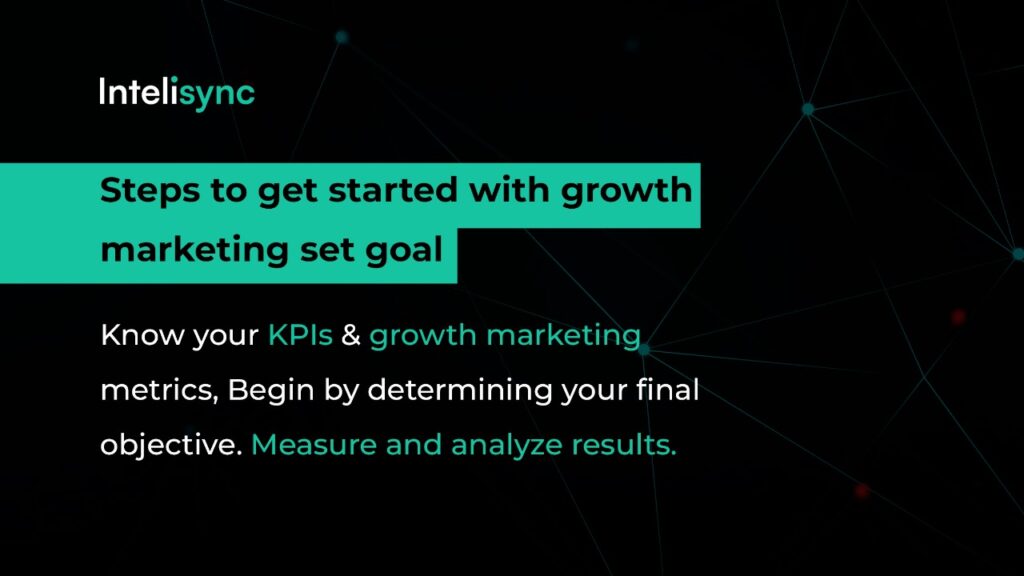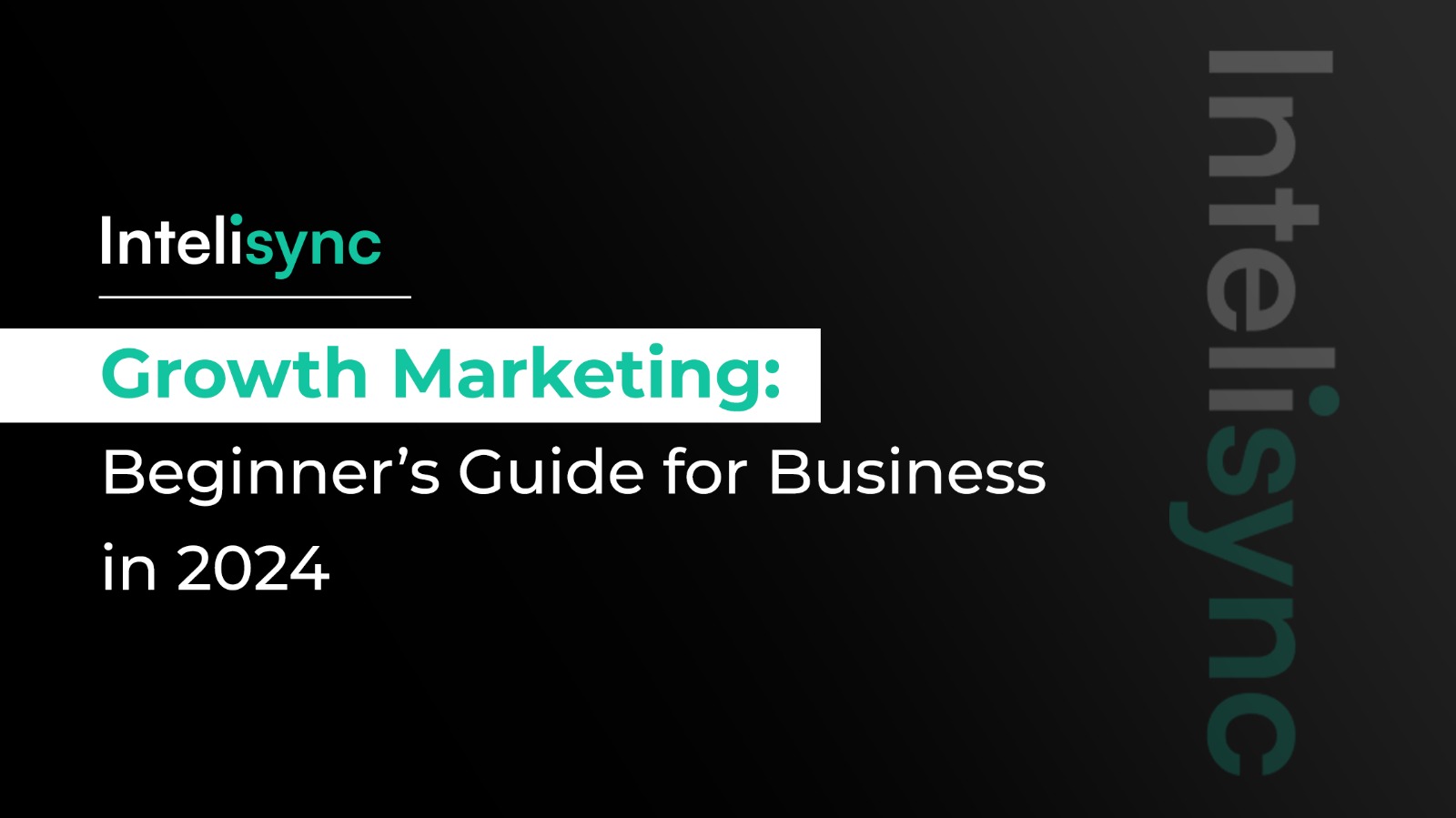In the changing world of 2024, when competition is severe and traditional techniques fail, one strategy stands out: Growth Marketing.
In the below we will cover you from the fundamental concepts of McClure’s AARRR approach to the complexities of goal planning and measure analysis, we’ll provide you with the information and skills you need to succeed.
Growth marketing is the process of using data from marketing campaigns and experimentation to generate growth. It can help you anticipate change and prepare a plan for continuous improvement.
Intelisync Growth Marketing Services specializes in assisting businesses like yours in achieving their objectives by utilizing the power of Growth Marketing. With our knowledge, experience, and constant support, your company may achieve new heights of success.
Key Takeaways:
- Clear goals and metrics tracking are essential for effective growth marketing strategies.
- Beyond traditional metrics like conversion rates, incorporating deeper metrics such as virality coefficient and time spent can provide valuable insights.
- Building growth marketing strategies with long-term goals in mind ensures sustainable growth and competitiveness.
- Utilizing data analysis and running experiments like A/B testing, continuous optimization, and iteration are crucial for improving campaigns and maximizing results.
Digital ad spending is predicted to reach $21 billion over the next five years, sparking heated competition among firms. Understanding and implementing growth marketing strategies is critical for firms seeking to flourish in 2024, as market landscapes continually evolve. This blog discusses excellent strategies and tips on How a
Growth Marketing Agency Can Help Your Business in Today’s Competitive Market.
Let’s start with What is Growth Marketing
What Does Growth Marketing Mean?
The next step in the marketing industry’s progression is growth marketing. This sort of marketing maximizes your efforts by using techniques like A/B testing, email marketing, search engine optimization (SEO), and data analysis to adopt smarter, more successful growth tactics. It focuses on experimentation, data analysis, and constant optimization to determine the most successful client acquisition and retention techniques.
Growth marketing shortens innovation cycles instead of relying on long-term efforts. The goal is to start small and collect information on which marketing initiatives are most efficient. Then, focus your efforts on the channels that the data recommends.
Importance of Growth Marketing in 2024
In 2024, the corporate world will be more competitive and turbulent than ever before. Traditional marketing tactics frequently fail to meet consumers’ changing requirements and preferences. Growth marketing, with its emphasis on agility, innovation, and quantitative results, provides firms with a competitive advantage when overcoming uncertainty and capitalizing on emerging opportunities.
Differentiating Growth Marketing from Traditional Marketing
Traditional marketing depends heavily on static tactics and mass communication channels, whereas growth marketing prioritizes personalized interactions, data-driven decision-making, and iterative experimentation. Traditional marketing aims to attract a large audience, whereas growth marketing focuses on focused engagement with high-potential consumers to maximize conversion rates and long-term value.
| Basis | Growth Marketing | Traditional Marketing |
| Method | Acquisition, Retention and Up-Selling | Acquisition Only |
| Flexibility | Quickly adapt to market changes | Slower to adapt due to set strategies |
| Objectivite | It focus more on rapid growth in customer base and revenue | Building brand awareness and reputation |
| Budget | Less Budget | Larger Budget |
| Decisions | Strategy and data-driven | Campaign and tactic-driven |
Steps to get started with Growth Marketing

Growth marketing is a data-driven marketing strategy that aims at optimizing each stage of the “pirate funnel” through constant testing.
You can’t talk about growth marketing without knowing McClure’s “AARRR” strategy and how it offers a small firm an advantage over its larger competition.
First, let’s discuss what AARRR stands for:
- Acquisition: The Acquisition stage involves tracking a potential customer’s initial contact with your business through your many channels (social media, blog, live chat widget, etc.). How much traffic do you receive to your website or online presence?
- Activation: The Activation stage is when you determine the first time someone interacts with your business. This might be challenging because “engaged” implies several meanings for various companies. In short, how many conversions do you receive from things like email subscriptions or people contacting you for a quote?
- Retention: The Retention stage is where you urge people to continue engaging with your company following their first sign up or purchase. Retention metrics are the data you have on how new customers or leads re-engage with your business. You have an abundance of information and techniques at your fingertips to help with retention. Email marketing is one of the most popular platforms for client retention. In a nutshell how many repeat clients do you have in comparison to new consumers?
- Referral: The Referral stage is when you determine which channels get the most suggestions from existing customers. That way, you can focus your marketing efforts on those channels and achieve more development through word-of-mouth marketing.
- Revenue: The Revenue stage is when your customers spend money on your products or services. The revenue stage is important to consider for growth marketing.
Lets see how you can start growth marketing and we will illustrate with some examples from our learnings over time working with multiple clients to help you understand it better
Set A Goal:
Define clear targets and key performance indicators (KPIs) to assess the effectiveness of your growth marketing initiatives. If you’re beginning from scratch with your growth marketing plan, you might want to improve in each of the six areas listed above. This involves establishing different goals for each category and working towards them one at a time.
Every organization must create its own high-level goal and identify which measures indicate whether or not the goal has been achieved. For instance, if you want to increase income, you may set the following goal: “I want to increase the average spend per customer on my website by 10% by the end of this year.”
One of our gaming clients came to us with the goal of “increasing user engagement.” They had tried to run giveaways, content creation and other activities to increase engagement, however they were not seeing great results.
After analyzing their metrics, we helped them set a clear goal: “To increase daily active users by 20% within three months.” By focusing their efforts on a specific metric, we were able to implement targeted and highly iterative strategies like sustainable token incentive contests, player rewards, and other strategies that significantly boosted user engagement and conversions.
Know your KPIs and growth marketing metrics:
Now that you’ve established your high-level goal, you can break it into smaller targets. Consider which channels are generating the most growth. Businesses frequently focus on conversion milestones that attract prospects and convert them into high-paying clients.
To achieve major conversion goals, focus on converting blog readers into subscribers, increasing free-to-paid or trial-to-paid conversions, increasing product rigidity, and driving viral growth.
Keep those mentioned conversion goals in mind as you prepare to design a growth plan for your firm.
We worked with a Web3 publication that lacked clarity on their growth metrics.
They were tracking basic metrics like Conversion rate of blog readers to email subscribers, Free trial sign-ups to paid subscription conversion rate only aiming for general targets.
Upon analysis, we identified crucial KPIs like:
Product engagement metrics such as time spent on platform and feature usage frequency. Viral coefficient indicating the rate at which existing users bring in new users through referrals
By understanding these specific metrics, we devised a tailored growth plan.
For instance, we optimized their content strategy to increase blog subscriber conversions, enhanced onboarding processes to boost trial-to-paid conversions, and implemented gamification features to drive product engagement and encourage viral growth. This targeted approach resulted in significant improvements across all key metrics, propelling the business towards sustainable growth in the Web3 ecosystem.
Begin by determining your final objective.
Because you’re concerned with more than just attracting new customers, you must be clear about the outcomes you expect to achieve in the coming years. Once you’ve determined your planned outcome, choose the growth framework that best fits your final objective.
To develop a sustainable growth marketing plan, you must first understand your consumer and their journey. Identify the touchpoints where prospective customers contact your brand and optimize each stage for optimum conversion.
Before collaborating with our agency, a Web3 business lacked a clear final objective beyond acquiring new customers. We guided them to define their long-term outcomes, such as establishing themselves as a leader in their niche and achieving sustainable revenue growth over the next few years.
By understanding their ultimate goal, we tailored a growth framework that aligned with their objectives, focusing on metrics beyond customer acquisition, such as brand authority and lifetime customer value.
Additionally, we conducted a thorough analysis of their customer journey, identifying touchpoints and optimizing each stage for maximum conversion by using our AI team’s help in creating hyper personalized AI driven content, resulting in a more cohesive and effective growth marketing strategy.
Measure and Analyze Results:
Continuously monitor and analyze significant metrics to discover opportunities for improvement and optimization. Collect the information from your experiments and compare it to your original hypothesis. When analyzing your results and making adjustments, ensure that the data you use is as precise and useful as possible, with no outlying data points.
Once you’ve applied your modifications, the following step is to continue testing. Growth marketing is a dynamic process that demands ongoing analysis, optimization, and development.
In a recent campaign for a Web3 DeFi platform, we conducted an A/B test to determine the most effective messaging approach: emphasizing security features or highlighting a user-friendly interface. The variant focusing on the user-friendly interface significantly outperformed the security-focused variant in terms of conversion rates and user engagement.
This insight enabled us to optimize the campaign messaging, leading to higher user adoption and better overall results. A/B testing proved instrumental in making data-driven decisions and refining marketing strategies for maximum effectiveness.
Intelisync Growth Marketing Services
A growth marketing firm specializes in assisting organizations with the implementation and optimization of growth marketing strategies to accomplish their business goals. data-driven solutions supported by strategic experimentation. We are a full-service digital firm that provides comprehensive services with the ultimate objective of optimizing your business’s development and income.
How Intelisync Growth Marketing Services Will Help Your Business
- Data-driven solutions: We are a full-service digital firm that provides comprehensive services with the final objective of optimizing your business’s development and revenue.
- Expertise and Experience: Expertise and Experience: Growth marketing companies offer specialized expertise and experience to bring to the table, supporting organizations in successfully navigating complicated marketing environments.
- Scalability and Flexibility: development marketing companies may scale their services based on the demands and development path of the company, allowing for flexibility and adaptation in dynamic circumstances.
- Support: We are 24/7 available for clients through chat, call, and email.

FAQs
What are the key components of a growth marketing strategy?
An effective growth marketing strategy combines targeted audience segmentation, personalized messaging, data-driven experimentation, and continual optimization to create scalable and long-term growth.
Is growth marketing applicable to all sorts of businesses?
While growth marketing concepts apply to a wide range of sectors and company models, their applicability is determined by criteria such as target audience characteristics, market dynamics, and resource availability.
What is the difference between Growth Marketing and Growth Hacking?
Growth marketing is when you dedicate all of your business efforts to building an audience or community of brand loyalists. It’s focused on building an audience rather than selling products. This larger idea facilitates the expansion of an audience and the testing of numerous channels, whereas growth hacking is executing a specific approach on a single channel to increase that audience.
Growth hacking often utilizes unusual and resource-efficient strategies to achieve quick expansion, with a focus on viral marketing, product optimization, and utilizing existing platforms. Growth marketing, on the other hand, covers a larger variety of techniques, including traditional marketing channels, with a focus on long-term growth through data-driven experimentation and optimization.
What are some common blunders to avoid in growth marketing?
Common mistakes in growth marketing include failing to set clear targets and KPIs, not doing enough audience research, relying too much on short-term tactics, and undervaluing the importance of constant optimization and adaptability.
Conclusion:
Finally, growth marketing signifies a fundamental transformation in how firms approach marketing and growth. Businesses that adopt agility, innovation, and data-driven strategies can open up new possibilities for expansion and competitiveness in the changing environment of 2024.
Businesses that use these concepts and approaches can face the challenges of today’s industry and achieve long-term success in 2024 and beyond.
Partnering with our agency can be a game-changer for startups looking to supercharge their growth marketing efforts in the dynamic Web3 landscape.
By leveraging our expertise, startups gain access to tailored strategies and cutting-edge techniques designed to drive tangible results. From defining clear goals and identifying key metrics to implementing personalized customer experiences and conducting rigorous data analytics, we offer a comprehensive approach to growth marketing.
Through strategic optimization and continuous analysis, startups can expect to see improvements across key metrics such as user acquisition, engagement, and lifetime value.
Our data-driven approach ensures that every marketing dollar is maximized, leading to accelerated growth and long-term success in the competitive Web3 ecosystem. With our agency as a trusted partner, startups can unlock their full potential and achieve their growth objectives with confidence.

One thought on “Growth Marketing: Beginner’s Guide for Business in 2024”